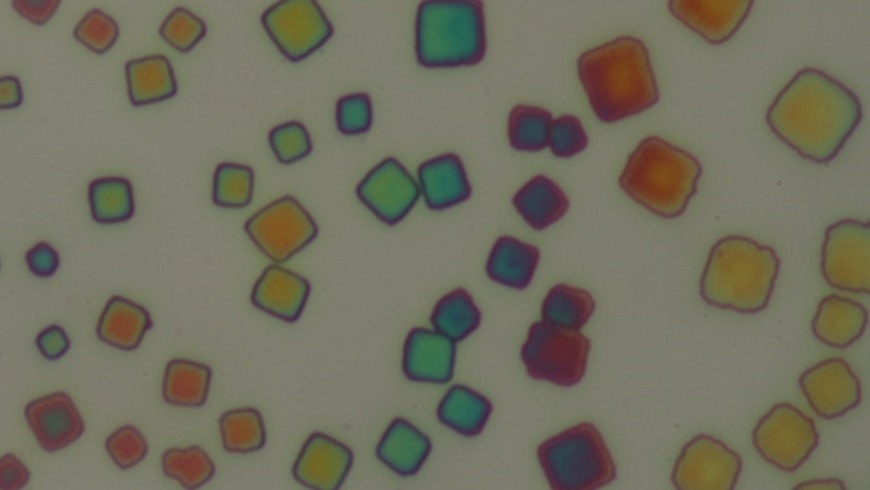Nov 9 2018
Superfluorescence is a phenomenon, where excited photo-emitters can cooperate and radiate at the same time. This effect with long-range ordered nanocrystal superlattices has now been created by scientists from Empa and ETH Zurich, along with coworkers from IBM Research Zurich.
 Superlattices under the microscope (white light illumination). (Image credit: Empa)
Superlattices under the microscope (white light illumination). (Image credit: Empa)
This latest discovery can possibly lead to future developments in quantum communication quantum sensing, LED lighting, and future quantum computing. The results of the study have been reported in the popular journal, Nature.
When certain materials are excited by an external source, for example, a laser, they spontaneously emit light. This phenomenon is called fluorescence. Yet, in a number of quantum systems and gases, there may occur a more intense emission of light when the emitters inside an ensemble spontaneously synchronize their quantum mechanical phase with one another and act in unison upon excitation. In this manner, the ensuing light output can be relatively more powerful when compared to the sum of the individual emitters, resulting in a bright, ultrafast emission of light called superfluorescence. However, this phenomenon only takes place when those emitters fulfill rigorous requirements, for example, possessing the same emission energy, a long coherence time, and high coupling strength to the light field. Per se, the emitters are powerfully interacting with one another and yet they are not easily affected by their environment. Until now, this has not been possible through technologically applicable materials.
Colloidal quantum dots might just provide the solution. They are established, commercially attractive solutions that are already being used in many next-generation LCD television displays and they also meet all the requirements.
A research team at ETH Zurich and Empa, headed by Maksym Kovalenko, along with coworkers from IBM Research Zurich, has now demonstrated that the new generation of quantum dots made of lead halide perovskites provides a smart and almost easy way to superfluorescence on-demand.
To demonstrate this, the team arranged perovskite quantum dots into a three-dimensional (3D) superlattice, which allow the coherent collective emission of photons, thereby producing superfluorescence. This offers the basis for sources of entwined multi-photon states, a major missing resource for photonic quantum computing, quantum imaging, and quantum sensing.
“Birds of a feather flock together”
However, a coherent coupling among quantum dots demands that they all have the same composition, size, and shape, since “birds of a feather flock together” in the quantum universe as well.
Such long-range ordered superlattices could only be obtained from a highly monodisperse solution of quantum dots, the synthesis of which had been carefully optimized over the last few years.
Maryna Bodnarchuk, Senior Scientist, Empa
With such kinds of “uniform” quantum dots of different sizes, the researchers might then form superlattices by precisely controlling the solvent evaporation.
The last proof of superfluorescence arose from optical experiments carried out at temperatures of about −267 °C. The team discovered that photons were emitted at the same time in a bright burst.
This was our ‘Eureka!’ moment. The moment we realized that this was a novel quantum light source.
Gabriele Rainó, ETH Zurich and Empa
The investigators regard these experiments as an initiating point to further leverage the collective quantum phenomena with this special class of material.
As the properties of the ensemble can be boosted compared to just the sum of its parts, one can go way beyond engineering the individual quantum dots.
Michael Becker, ETH Zurich and IBM Research
The controlled production of superfluorescence and the associated quantum light can pave the way to innovative possibilities in quantum-encrypted communication, quantum sensing, LED lighting, and future quantum computing.